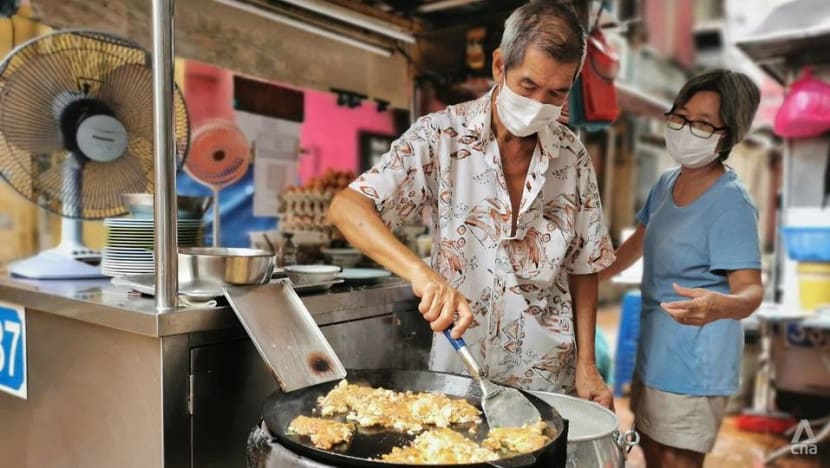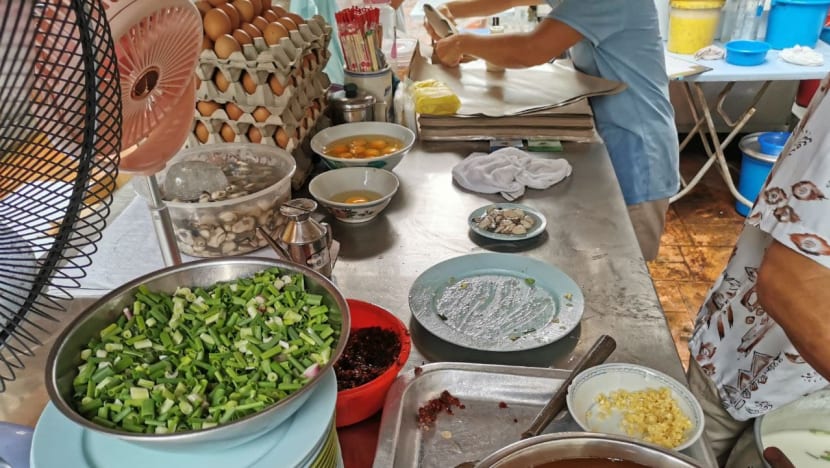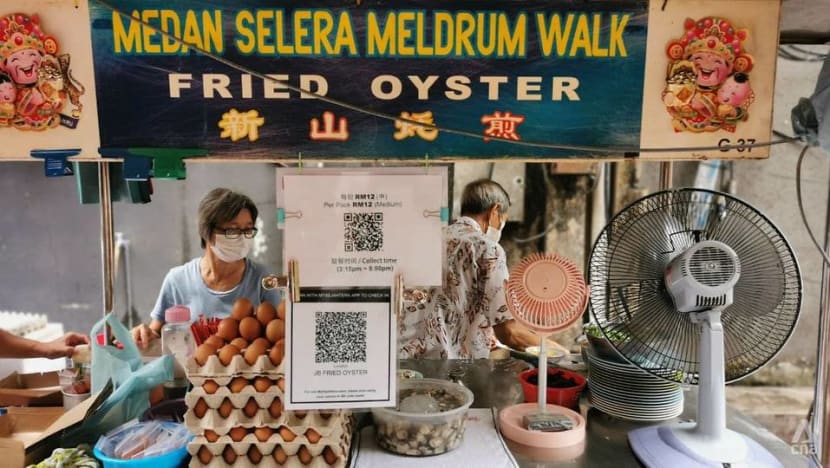This humble oyster omelette stall in JB is thriving despite COVID-19
The pandemic has crippled many eateries in JB. However, this orh luak stall, run by an elderly couple and their son, has tweaked its business strategy to survive amid tough times.

Throughout their 40 years of marriage, Fong Ah Seng and Go E Cheng have been operating the oyster omelette stall together. (Photo: Amir Yusof)
JOHOR BAHRU: Almost all of the food carts along Meldrum Walk food street have been padlocked and shunted to the side.
The alley, located a mere 500m from the immigration complex linked to the Woodlands Causeway, was previously teeming with visitors from Singapore craving for a taste of affordable, delectable Malaysian Chinese street food.
However, with the pandemic enforcing border closures over the last year, only a handful of stalls were left operating.

In a nondescript corner of the lane, the sizzling sound from a large pan at a stall named JB Fried Oyster broke the silence on a drizzly Wednesday afternoon.
An elderly couple – Fong Ah Seng and Go E Cheng – and their son Richard Fong were cramped in a small space of around 5 sq m behind the food cart.
Fong prepared the ingredients and stir-fried the omelette on a piping hot gas pan, Go packed the food into cardboard packaging while Richard helmed the register and handled orders on his phone.

In a city that has been beleaguered by the economic effects of COVID-19, this stall’s ability to not only survive, but thrive, has made it a success story in these troubled times.
The key to this success is its fluffy fried oyster omelette, which has locals from across the state coming back for more.
Fried oyster omelette, more commonly known by its colloquial Teochew term “orh luak”, is a beloved hawker dish sold in many eateries across Malaysia and Singapore.
But what makes this stall’s dish outstanding, according to many of its fans online, is its wok hei. Wok hei is a Cantonese term referring to the smoky aroma imparted to food that has been tossed and seared at high heat.

Fong said that the all-important char comes from knowing how to fry and handle the omelette at the right temperature.
“Practice makes it perfect. I’ve been doing this for more than 50 years,” he said.
DECADES OF EXPERIENCE
The 72-year-old first learnt how to make orh luak as an 18-year-old junior chef working at a restaurant in JB that specialised in Chinese cuisine.
The restaurant’s owner, a Chinese national, taught him the recipe. A few years later, Fong left the job and opened his own stall in downtown Johor Bahru.
READ: Taste of home - Malaysian actress offers Kelantan food at Toa Payoh hawker stall
Fong’s technique of frying each batch of omelette is a work of art.
He first ladles milky white slurry batter onto the hot pan, and as it sets slightly, he pours in more than two dozen eggs. With his trusty spatula, Mr Fong breaks the yolks and stirs the mixture gracefully, in small concentric circles.
Dipping the spatula into a large bowl of lard nearby, Fong deftly flicks some lard into the pan every now and then. At the right juncture, he adds chives, garlic or further seasoning based on the orders.

Once the omelette is set and golden brown, Fong throws in fresh oysters the size of 50 cent coins, which are imported fresh from Thailand that same morning.
He then portions and serves the thick, fluffy omelette in packs of brown greaseproof paper inside small cardboard boxes, accompanied by a small container of fish sambal.
“People eat it as a snack, or part of a main meal. That’s the beauty about this dish,” said Fong.
Go, 63, has been married to Fong for around 40 years and she has been his helper throughout their marriage. Yet, not once has she held the spatula and made the omelette.
“He is the only one that knows how to fry them perfectly, so it's best I do not spoil the quality for our customers,” she added.

Richard, their son who quit his career as an IT programmer to help further the family business, echoed similar sentiments.
“My father is the best at frying. He has taught me how to do it, but he’s still the best at it. One day I will take over, but as long as he is strong enough to do it, I will let him be,” said Richard.
TAKING ORDERS ONLINE
The trio works four days a week, and on a good day, sells 100 to 200 packs of oyster omelette at RM12 (US$2.90) each.
COVID-19 has curtailed tourism from Singapore and reduced local foot traffic along the alley.
However, Richard has helped pivot the stall to take orders online, and this has allowed it to continue to operate through this pandemic.
“We have become popular through word of mouth so we then decided to open a Facebook page (JB Fried Oyster) to update our customers on our operating hours, and also how to take orders,” said Richard.
READ: Singapore-style fried Hokkien prawn mee woos Malaysian foodies in Petaling Jaya
The Facebook page has more than 13,000 followers, both locals and Singaporeans.
“Since COVID, we’ve been getting a lot of orders in bulk. People will buy in huge boxes, 30 to 40 packs and take them to their hometowns in Kulai, Batu Pahat or wherever and resell them,” said Richard.
“With the pandemic, people don’t like to go out of their homes to buy food. So this kind of delivery service appeals to many families,” he added.
He said that when COVID-19 first closed borders in March 2020, his family store lost about 20 per cent of business, mostly from Singaporean customers.

However, their new business strategy to go online and focus on the local market has borne dividends, and the store is doing even better than in 2019, pre-pandemic.
“We’re happy that we are able to still survive and make money now. Along this lane, only one other chicken wing stall is open. The other stalls, especially those who offer dining in options like lok lok or yong tau foo cannot survive,” he added.
Richard explained that after the movement control order was implemented in March last year, many of these stalls selling Chinese street food were forced to close, and almost all of them have yet to reopen.
Luckily for Richard, his family's stall continued to receive orders due to its popularity through word of mouth and social media.
The stall has also garnered fame online after a video of Fong in action, published by Singapore-based foodie YouTube channel DancingBacons in November 2019, went viral.
The video has chalked up 11 million views and attracted many comments, including those from netizens all over the world. Many lauded Fong for his frying skills and for working hard to make a masterpiece.
Fong was shocked to see the social media interactions the clip had, and said he felt “touched” by many of the responses.
“One day when the border reopens, I hope many of these people will come down to our stall so they can try the omelette,” said Fong.
“It tastes as good as it looks,” he added.












